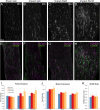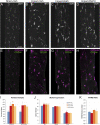Raloxifene Modulates Microglia and Rescues Visual Deficits and Pathology After Impact Traumatic Brain Injury
- PMID: 34776838
- PMCID: PMC8585747
- DOI: 10.3389/fnins.2021.701317
Raloxifene Modulates Microglia and Rescues Visual Deficits and Pathology After Impact Traumatic Brain Injury
Abstract
Mild traumatic brain injury (TBI) involves widespread axonal injury and activation of microglia, which initiates secondary processes that worsen the TBI outcome. The upregulation of cannabinoid type-2 receptors (CB2) when microglia become activated allows CB2-binding drugs to selectively target microglia. CB2 inverse agonists modulate activated microglia by shifting them away from the harmful pro-inflammatory M1 state toward the helpful reparative M2 state and thus can stem secondary injury cascades. We previously found that treatment with the CB2 inverse agonist SMM-189 after mild TBI in mice produced by focal cranial blast rescues visual deficits and the optic nerve axon loss that would otherwise result. We have further shown that raloxifene, which is Food and Drug Administration (FDA)-approved as an estrogen receptor modulator to treat osteoporosis, but also possesses CB2 inverse agonism, yields similar benefit in this TBI model through its modulation of microglia. As many different traumatic events produce TBI in humans, it is widely acknowledged that diverse animal models must be used in evaluating possible therapies. Here we examine the consequences of TBI created by blunt impact to the mouse head for visual function and associated pathologies and assess raloxifene benefit. We found that mice subjected to impact TBI exhibited decreases in contrast sensitivity and the B-wave of the electroretinogram, increases in light aversion and resting pupil diameter, and optic nerve axon loss, which were rescued by daily injection of raloxifene at 5 or 10 mg/ml for 2 weeks. Raloxifene treatment was associated with reduced M1 activation and/or enhanced M2 activation in retina, optic nerve, and optic tract after impact TBI. Our results suggest that the higher raloxifene dose, in particular, may be therapeutic for the optic nerve by enhancing the phagocytosis of axonal debris that would otherwise promote inflammation, thereby salvaging less damaged axons. Our current work, together with our prior studies, shows that microglial activation drives secondary injury processes after both impact and cranial blast TBI and raloxifene mitigates microglial activation and visual system injury in both cases. The results thus provide a strong basis for phase 2 human clinical trials evaluating raloxifene as a TBI therapy.
Keywords: CB2 receptors; inflammatory responses; microglia; mouse model; neuroinflammation; raloxifene; traumatic brain injury; visual deficits.
Copyright © 2021 Honig, Del Mar, Henderson, O’Neal, Doty, Cox, Li, Perry, Moore and Reiner.
Conflict of interest statement
The authors declare that the research was conducted in the absence of any commercial or financial relationships that could be construed as a potential conflict of interest.
Figures









Similar articles
-
Raloxifene, a cannabinoid type-2 receptor inverse agonist, mitigates visual deficits and pathology and modulates microglia after ocular blast.Exp Eye Res. 2022 May;218:108966. doi: 10.1016/j.exer.2022.108966. Epub 2022 Feb 7. Exp Eye Res. 2022. PMID: 35143834
-
Amelioration of visual deficits and visual system pathology after mild TBI with the cannabinoid type-2 receptor inverse agonist SMM-189.Exp Eye Res. 2019 May;182:109-124. doi: 10.1016/j.exer.2019.03.013. Epub 2019 Mar 26. Exp Eye Res. 2019. PMID: 30922891 Free PMC article.
-
Amelioration of visual deficits and visual system pathology after mild TBI via the cannabinoid Type-2 receptor inverse agonism of raloxifene.Exp Neurol. 2019 Dec;322:113063. doi: 10.1016/j.expneurol.2019.113063. Epub 2019 Sep 10. Exp Neurol. 2019. PMID: 31518568
-
Microglial activation as a compelling target for treating acute traumatic brain injury.Curr Med Chem. 2015;22(6):759-70. doi: 10.2174/0929867321666141106124657. Curr Med Chem. 2015. PMID: 25386818 Review.
-
Understanding microglial responses in large animal models of traumatic brain injury: an underutilized resource for preclinical and translational research.J Neuroinflammation. 2023 Mar 9;20(1):67. doi: 10.1186/s12974-023-02730-z. J Neuroinflammation. 2023. PMID: 36894951 Free PMC article. Review.
Cited by
-
Visual Impairment in Pre-Clinical Models of Mild Traumatic Brain Injury.J Neurotrauma. 2024 Aug;41(15-16):1842-1852. doi: 10.1089/neu.2023.0574. Epub 2024 May 2. J Neurotrauma. 2024. PMID: 38497739 Free PMC article. Review.
-
Etiology of Idiopathic Macular Holes in the Light of Estrogen Hormone.Curr Issues Mol Biol. 2023 Jul 29;45(8):6339-6351. doi: 10.3390/cimb45080400. Curr Issues Mol Biol. 2023. PMID: 37623219 Free PMC article. Review.
-
Neurochemistry and circuit organization of the lateral spiriform nucleus of birds: A uniquely nonmammalian direct pathway component of the basal ganglia.J Comp Neurol. 2024 May;532(5):e25620. doi: 10.1002/cne.25620. J Comp Neurol. 2024. PMID: 38733146 Free PMC article.
-
Raloxifene Mitigates Emotional Deficits after Mild Traumatic Brain Injury in Mice.Neurotrauma Rep. 2022 Nov 24;3(1):534-544. doi: 10.1089/neur.2022.0052. eCollection 2022. Neurotrauma Rep. 2022. PMID: 36479361 Free PMC article.
-
Human amnionic progenitor cell secretome mitigates the consequence of traumatic optic neuropathy in a mouse model.Mol Ther Methods Clin Dev. 2023 Apr 18;29:303-318. doi: 10.1016/j.omtm.2023.04.002. eCollection 2023 Jun 8. Mol Ther Methods Clin Dev. 2023. PMID: 37359418 Free PMC article.
References
-
- Anyaegbu C. C., Mao Y., McGonigle T., Raja S., Clarke T., Black A. M. B., et al. (2021). Simultaneous flow cytometric characterization of multiple cell types and metabolic states in the rat brain after repeated mild traumatic brain injury. J. Neurosci. Methods 359:109223. 10.1016/j.jneumeth.2021.109223 - DOI - PubMed
LinkOut - more resources
Full Text Sources
Research Materials

